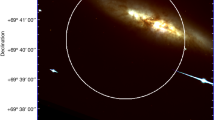Abstract
We report here preliminary evidence for γ-ray line emission from the region of SS433. The observations were accomplished with the high-resolution γ-ray spectrometer aboard the HEAO 3 satellite1. One of the line features reported here, located at an energy of 1.5 MeV, has a statistical significance of ∼6 σ during a particular 18-day interval. Another feature appears near 1.2 MeV. Both features exhibit fractional linewidths, ΔE/E, of ∼1%. The intensity of the 1.5-MeV feature is variable by a factor of ∼3 on a time scale of days with a 46-day time average value of 1.5±0.3×10−3 photons cm−2 s−1. The 1.2-MeV feature is similarly variable with a time average intensity of 1.1±0.2×10−3 photons cm−2 s−1. The combined power in the lines is ∼2 × 1037 erg s−1, assuming isotropic emission from SS433. Phenomena previously observed2,3 from SS433 have been interpreted in terms of a kinematic model4,5 in which two oppositely directed jets of relativistic material (ν = 0.26c) are ejected from a central source. Our observed energies may be explained in terms of this kinematic model as blue- and red-shifted components of the 1.369-MeV line from a nuclear transition of 24Mg from its first excited state to its ground state. Both components appear to vary in energy over the duration of the observation in a manner roughly consistent with the pattern seen in the optical regime2, in which ‘movement’ of optical features is accounted for by a precession of the axis of the jets with a 163.51-day period6. However, this identification implies an anomolously high magnesium abundance relative to carbon and oxygen.
This is a preview of subscription content, access via your institution
Access options
Subscribe to this journal
Receive 51 print issues and online access
$199.00 per year
only $3.90 per issue
Buy this article
- Purchase on Springer Link
- Instant access to full article PDF
Prices may be subject to local taxes which are calculated during checkout
Similar content being viewed by others
References
Mahoney, W. A., Ling, J. C., Jacobson, A. S. & Tapphorn, R. M. Nucl. Instrum. Meth. 178, 363–381 (1980).
Margon, B. et al. Astrophys. J. Lett. 230, L41–L45 (1979).
Hjellming, R. M. & Johnston, K. J. Astrophys. J. Lett. 246, L141–L145 (1981).
Abell, G. O. & Margon, B. Nature 279, 701–703 (1979).
Milgrom, M. Astr. Astrophys. 76, L3–L6 (1979).
Margon, B. in Accretion Driven Stellar X-Ray Sources (eds Lewin, W. H. G. & van den Heuvel, E. P. J.) (Cambridge University Press, 1982).
Marshall, F. E., Swank, J. H., Boldt, E. A., Holt, S. S. & Serlemitsos, P. J. Astrophys. J. Lett. 230, L145–L148 (1979).
Brownlee, K. A. Statistical Theory and Methodology in Science and Engineering, 86 (Wiley, New York, 1960).
Ramaty, R., Kozlovsky, B. & Lingenfelter, R. E. Astrophys. J. Suppl. 40, 487–526 (1979).
Mahoney, W. A., Ling, J. C. & Jacobson, A. S. Nucl. Instrum. Meth. 185, 449–458 (1981).
Davidson, K. & McCray, R. Astrophys. J. 241, 1082–1089 (1980).
Begelman, M. C., Sarazin, C. L., Hatchett, S. P., McKee, C. F. & Arons, J. Astrophys. J. 238, 722–730 (1980).
Author information
Authors and Affiliations
Rights and permissions
About this article
Cite this article
Lamb, R., Ling, J., Mahoney, W. et al. γ-Ray line emission from SS433. Nature 305, 37–39 (1983). https://doi.org/10.1038/305037a0
Received:
Accepted:
Issue Date:
DOI: https://doi.org/10.1038/305037a0
This article is cited by
-
Problems with non-thermal models for the narrow line gamma rays reported from SS 433
Astrophysics and Space Science (1988)
-
Identification of γ-ray lines observed from SS433
Nature (1984)
Comments
By submitting a comment you agree to abide by our Terms and Community Guidelines. If you find something abusive or that does not comply with our terms or guidelines please flag it as inappropriate.



